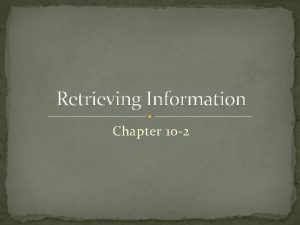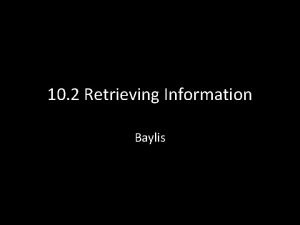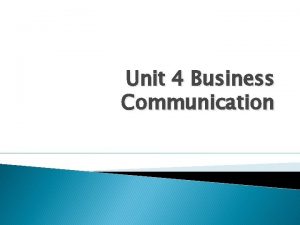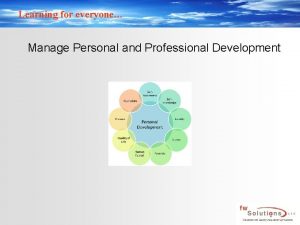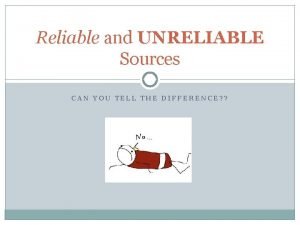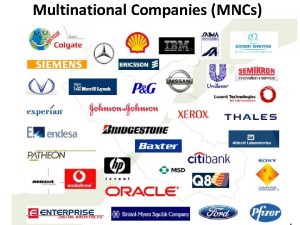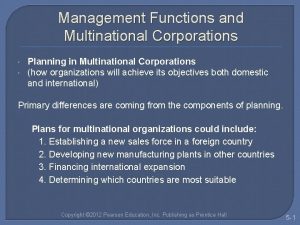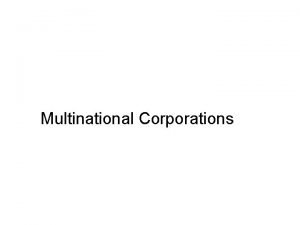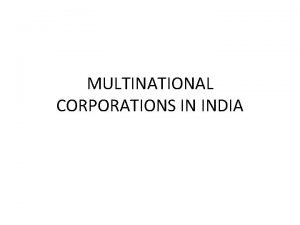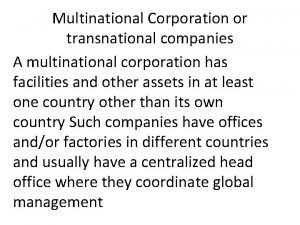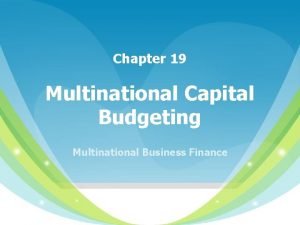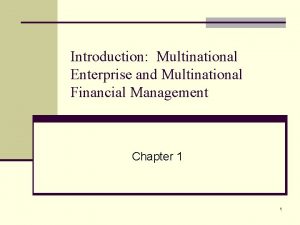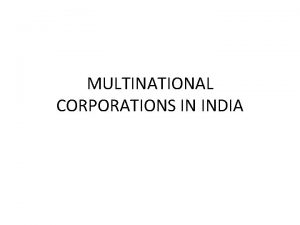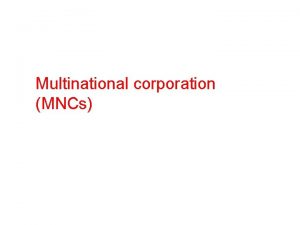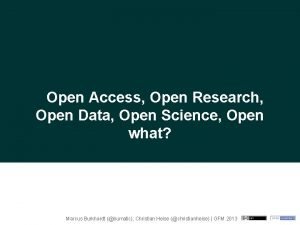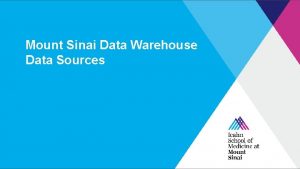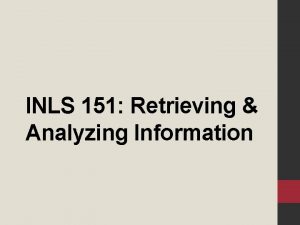Open data sources for retrieving information on Multinational




















- Slides: 20

Open data sources for retrieving information on Multinational Enterprise Groups Meeting of the Group of Experts on Business Registers 30 September – 2 October 2019 Geneva, Switzerland

Content • • What is Euro. Groups Register (EGR) Short overview of DBpedia Feasibility study objectives Results for proof of concept • • Coverage Completeness Accuracy Timelines • Conclusions 2

What is EGR? • The Euro. Groups Register (EGR) is a statistical business register of multinational enterprise groups in the EU Member States and in the EFTA countries • coverage: multinational groups present in Europe, their constituent enterprises and legal units • the EGR process is in operation since 2009 • For statistical use only • Restricted use in national statistical offices and national central banks of EU and EFTA countries 3

Information stored in the EGR • Legal units • Unique identifiers • Relationships: ownership shares / voting rights • LEU A controls LEU B with x% voting rights • Enterprises • Economic characteristics (turnover, employment) • Links to legal units • Groups • Group characteristics (turnover, employment) • Global decision centre 4

A MNE group in EGR • As a complete structure of legal units and their controlling relationships and the economic enterprises Enterprise 1 LEU B Enterprise Group Head LEU A LEU F LEU G Enterprise 4 LEU C LEU D LEU H LEU I Enterprise 2 LEU E Enterprise 3 Enterprise 5 LEU J LEU K 5

EGR 2. 0 process overview CDP Commercial data provider – CDP (LEU, REL) EGR NSI Identification service Identification of legal units Processing NSI and commercial data NSI data (LEU, REL, ENT) Initial and preliminary frames Consult and update preliminary frame and GEG data Final frame 6

Options for improving the EGR • The European part of the legal units, enterprises and enterprise groups are well-covered by EGR, but there is missing data for units outside of the EU and EFTA as well as for attributes on the group level. • Web crawling and different open data projects are seen as further opportunities to increase the quality of the EGR, its completeness and accuracy. 7

DBpedia « global and unified access to knowledge » • Started in 2008 as community effort for semiautomatic knowledge extraction from Wikipedia • One of the most successful open knowledge graphs (OKG) • working on https: //databus. dbpedia. org • Shared effort on KG Governance, Integration, Collaboration, Curation. . . • Pushes societal value and data economy • Maven with Git-for-data and persistent identifiers 8

DBpedia Extraction Framework Open source software which extracts structured semantic data (RDF) from Wikipedia (infoboxes) in order to make it publicly available as OKG • Execute sophisticated queries against Wikipedia data • Link different datasets to Wiki/DBpedia resources Example RDF Data for Siemens AG 9

Wikipedia Knowledge Extraction • project that extracts structured data from Wikipedia (infoboxes) in order to make it publicly available • Execute sophisticated queries against Wikipedia data • Link different datasets to Wikipedia data 10

Objectives of the feasibility study • The project goal was to create an interface that handles a list of groups names and returns a list of results with information on aggregate numbers for those groups. • The contractor, Leipzig University, was provided with a population of 73 group names in order to design an interface that fetches search results from DBpedia. 11

Proof of Concept Results This Proof of Concept focused on validating the following indicators: • Coverage – number of successful matched enterprise group names • Completeness – number of received values for the different attributes • Accuracy – quality of the returned values when compared to annual report data • Timelines – availability of data for certain reference period based on EGR cycle 12

Coverage 2016 • The searches carried out during the testing phase proved that 70 of 73 groups could be found in DBpedia. • The group names used were taken from a data set received from Dun and Bradstreet covering a selection of 3000 groups addressing groups size and geographical location diversity. 13

Completeness 2016 14

Accuracy 2016: Employees 15

Accuracy 2016: Turnover 16

Accuracy 2016: Assets 17

Timelines: Coverage 2014 - 2017 • The feasibility study foresees as well a historical mode that allows to retrieve data on enterprise groups even if Wikipedia data has already been updated with new data. • Due to the delay with which the EGR provides data on enterprise groups this feature is essential 18

Conclusions 1/2 • The DBpedia data production and integration into EGR process could not be fully automated. Further steps in a prototype phase will test the possibility of making cross reference links between EGR and DBpedia for better automation. • The highest percentage of data coverage achieved was for persons employed attribute still below 50% (42. 5%), for turnover it is 37. 0% and for assets 16. 4%. • The retrieved data on the three parameters showed high accuracy when compared to the figures published by the groups on their websites. 19

Conclusions 2/2 • The standardization and harmonization of annual financial reports (AFRs) in a single electronic reporting format provides further opportunities for collecting information on Multinational Enterprise Groups • Close collaboration between projects for retrieving data on MNEs from open sources, carried out in the different institutions, should be encouraged in order to share best practices and optimize use of resources 20
 10-2 retrieving information answers
10-2 retrieving information answers Vocabulary activity 10-2 retrieving information
Vocabulary activity 10-2 retrieving information Open innovation open science open to the world
Open innovation open science open to the world Print sources of information
Print sources of information Water resources important
Water resources important Data collection secondary data sources
Data collection secondary data sources Sources of information in business communication
Sources of information in business communication Compare sources of information on professional development
Compare sources of information on professional development What are unreliable sources
What are unreliable sources Autobiography as primary sources
Autobiography as primary sources Sources of technical information
Sources of technical information Kontinuitetshantering
Kontinuitetshantering Typiska novell drag
Typiska novell drag Nationell inriktning för artificiell intelligens
Nationell inriktning för artificiell intelligens Ekologiskt fotavtryck
Ekologiskt fotavtryck Shingelfrisyren
Shingelfrisyren En lathund för arbete med kontinuitetshantering
En lathund för arbete med kontinuitetshantering Personalliggare bygg undantag
Personalliggare bygg undantag Tidbok
Tidbok A gastrica
A gastrica Förklara densitet för barn
Förklara densitet för barn
